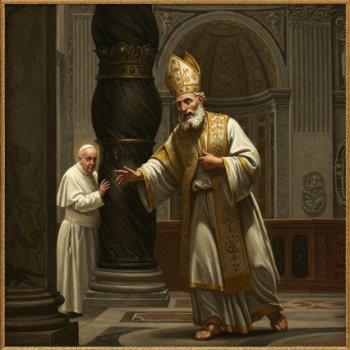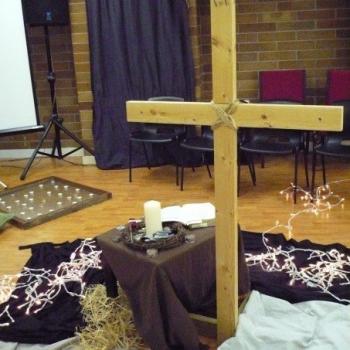After four posts responding to the first four points of Douglas Todd’s account of ‘liberal Christianity,’ St. Peter Fireside’s lead pastor Alastair Sterne has gotten to the one that could explode in their faces in an uncontrollable ball of flame.
Todd’s description of these explosive ‘sex-related’ items as ‘abortion, homosexuality, and not-so-hot-button items’ is more of a reference to what ‘liberal Christians’ might think of these items: no-brainers that ‘conservative Christians’ allegedly use to turn the clock back in the Dark Ages. Churl will appreciate the medievalism in that last statement. In Todd’s words:
Unfortunately, “hot-button” sex-related issues always draw the most intense media attention. Journalists generally focus on how conservative Christians go against the secular grain in opposing abortion, homosexuality, prostitution, divorce, sex outside marriage and contraception. Liberal Christians, on the other hand, have different degrees of openness to all these things, as well as to euthanasia.
In Todd’s word, ‘liberal Christians’ are allied with a secular agenda to liberalize sexuality. By contrast, ‘conservative Christians’ are conceptualized as going ‘against the secular grain’ in their lack of ‘openness to all these things, as well as to euthanasia.’
You could say that Sterne’s reply is an attempt to defuse the bomb. Echoing Todd’s ‘unfortunately,’ Sterne attempts to move the conversation about sexuality away from the media because for Sterne, the media broadcasting of these issues reduces conversation to soundbites and continues to marginalize those who still experience ‘pain’ from the overly public conversation. Sterne proposes that the proper place to do theology around these explosive issues is within the church, where pastoral care can be provided for people who are hurting. In this way, each person’s individual struggles can be dealt with individually, confidentially, and privately, and each person can be directed personally to find his or her (or xyr) journey converging with the matrix of the death and resurrection of Jesus Christ.
I recognize that Sterne’s ‘public theology’ is very much a work in progress. Check this out:
I am not against public theology, but problems arise when that public discourse happens in the media. When it comes to abortion, homosexuality, prostitution, divorce, sex outside marriage, contraception or euthanasia we are always talking about individuals. These people — made in the image of God — have stories more complicated and beautiful than soundbites can capture. We’re talking about people who need theology that can meaningfully meet them as they are and where they are, which is precisely what we all need. With no disrespect to the media, this simply cannot be found through that medium (nor on a blog for that matter!). The limitations of the medium can unintentionally dehumanize the people of “the issues.”
This, not the hot-button ‘sex-related’ issues, is the crux of Sterne’s argument. Some might say that it’s a cop-out, a way of addressing controversy without taking on the issues head-on.
I don’t. But I do think that Sterne contradicts himself about ‘public theology.’
It is difficult to understand, for example, the meaning of the sentence: ‘I am not against public theology, but problems arise when that public discourse happens in the media.’ What could this possibly mean? If ‘public discourse’ does not happen in the ‘media,’ then where does it happen? If one is not against public theology but is against public theology happening in the media, then how is one not against public theology? If one finds both the media and blogging problematic, then why does one take the time to address Douglas Todd’s media representation of ‘liberal Christianity’ on a blog?
This contradiction of views about the ‘public’ becomes even stranger when Sterne applies it to ‘the church.’ Arguing that ‘the medium through which people can encounter theology sturdy enough for the roads they’re traveling is the church,’ Sterne calls for the revitalization of the spiritual practice of ‘pastoral care.’ Sterne implies that ‘pastoral care’ is private because ‘this ancient practice requires trust,’ which ‘won’t be developed in overly condoning or condemning soundbites.’ Citing Aelred of Rievaulx’s Pastoral Prayer, Sterne makes a very strong case that denominational formulas about the hot-button issues ‘does not mean it [a denomination or church] knows where to stand with a person.’
The problem with conflating ‘the church’ with the private practice of ‘pastoral care,’ though, is that the ‘church’ is a public assembly. As New Testament professor Sam Tsang emphasizes over and over and over again on his blog, the word ekklesia simply referred to an assembly, a gathering of the city’s people to build the polis. The early Christians adopted the word ekklesia to refer to the gathered assemblies of the people brought together by Jesus Christ to build the city of God in the various cities of the Roman Empire — and beyond. Cross-referencing Dom Gregory Dix’s Shape of the Liturgy where he argues that these gatherings could be analyzed as ‘private’ before they became ‘public’ under Constantinian rule simply won’t do, either. If one follows Dix, what could be said to be private about the early ekklesiai was the Eucharistic liturgy, where those who had not yet been baptized would be sent away before those in Christ partook in the Body and the Blood of Christ. That’s not what Sterne is talking about, though. Sterne is talking strictly here about pastoral care and its location within the practices of the church, the publicly gathered people in the name of Jesus Christ.
Now, it is true that there came to be developed a very confidential practice in the life of the Christian church: confession. It’s so confidential that there are both canon and civic laws around the confidentiality of confession. Roman Catholic priests speak of the ‘seal,’ the absolute secrecy of everything that penitents confess to them, so much so that they practice simply forgetting all the juicy material that they are told. In Canada, confession in non-liturgical contexts went to court, all the way up to the Supreme Court of Canada in 1991, to determine whether everything confessed to a pastor could be confidential in a court of law. The answer was no – for example, murder confessed to a pastor outside of the sacramental context of confession — which, in a non-liturgical and non-sacramental context doesn’t exist — is fair game for the secular courts. So too, the whole craziness of the child sex abuse scandals that hit the Catholic Church and is now coming down through the evangelical pipeline has resulted in a requirement to let the civic authorities know whenever such crimes are perpetrated. Finally, even though confessions are themselves confidential, the example of even Pope Francis going to confession before serving as a confessor demonstrates that confession is not just about the individual but about the people of God getting right with God as a people. This makes sense in a big way: the whole idea of confession as a sacramental practice comes from the medieval penitentials that prescribed rites for confession and absolution — rites that, by the way, made their way into Protestantism via the Book of Common Prayer and in the current alternative service books — which again means that the point of confession is not a ‘me and God’ thing, but a ‘people of God’ thing.
In other words, while it might be wise for pastoral care to be confidential, the point is that it’s never private. In some ways, confession is a public act, not in the sense that all your secrets get spilled to the public, but in the sense that the city of God is built on confession, repentance, forgiveness, and reconciliation.
The trouble is that Sterne seems to think that the ecclesial public has always been separated from the secular public in which the press works. In a collection of essays on religion, critical theorist Michel Foucault observes that these publics are really both based on ‘confession.’ The only difference is that while the ecclesial public prescribed confession for Christians as a path by which humans are united to God, the state has elicited confessions to exert its subjugating power over citizens, especially by getting citizens to govern themselves (this is what Foucault famously called ‘governmentality’). What’s even more complicated is that this confessional state has often used the church as its arm of moral regulation: in Canada, the story has become familiar in the First Nations residential schools, anti-buggery laws, and the contested legacy missionary attempts in various Chinatowns. That the term ‘Christian privilege’ is the talk of the town in educational circles in British Columbia suggests not an anti-Christian orientation on the part of radical secular activists, but the need to talk about the effects of the past on the present when it comes to the church’s complicity in making a certain kind of Canadian governmentality.
The trouble is that even though the church’s fall from privilege might actually help the church to stop getting co-opted by the state, this process isn’t exactly happening quietly. In each of the examples that Todd raises — abortion, homosexuality, euthanasia, other ‘not-so-hot-button’ issues — journalists have been drawn to portrayals of conservative Christians as they have contested government policy positions, attempting to retain its pastoral power over the state.
But if the church were in fact to be the church, what Sterne might propose may not be pastoral care, but ecclesial performativity. As ‘classical Christians’ insist that they have been against abortion from the beginning — say, by rescuing infants in the Roman Empire from parents who abandoned them — theological ethicist Stanley Hauerwas has insisted that a truly pro-life stance requires that the church live out an alternate society in which abortion would be made unnecessary, not simply to require the state to outlaw it. Such a church would provide an environment in which having children could actually be imaginable in today’s flexible economy. Having understood St. Augustine’s City of God as framing the arrogant city of the pagans as founded on rape culture (think Lucrece in Rome), such a church would work tirelessly in solidarity with feminist activist groups to contest rape culture — which means that we should have heard churches speaking out when Rehtaeh Parsons’s suicide broke in the news and when Canadian universities’ orientation days featured underage rape chants. If indeed there is a case to be made for euthanasia about ‘quality of life,’ then if our churches really do oppose it, our churches must be welcome spaces for the disabled, the critically ill, the mentally challenged, and the aged. In much of this, the current Archbishop of Canterbury, Justin Welby, has provided a remarkable model. Without backing down from some of the socially conservative statements that the Church of England’s House of Bishops has made, Welby has gone out of his way to meet with LGBTQ+ activists and making statements that ‘we must have no track with any sort of homophobia,’ even going to lengths to get anti-homophobia curriculum into British schools.
In other words, Sterne may be correct to say that the media only tends to report ‘soundbites,’ but if the church were to actually speak a truly public theology, it would have to be through actions, not words. This is because at the end of the day, theology is performative — it isn’t so much about what we say and think, but what we do, that demonstrates who the God is in whom we claim to live and move and have our being. Given the public assembly of the ekklesia, the performances of the church, right down to the acts of confession, are never private acts. They are public, indicating to the world what the Christian church in fact believes about love for neighbours and enemies and the seeking of the common good.
It is on that public note that we look forward to what Sterne will say about the ancient spiritual practices in his sixth installment.















